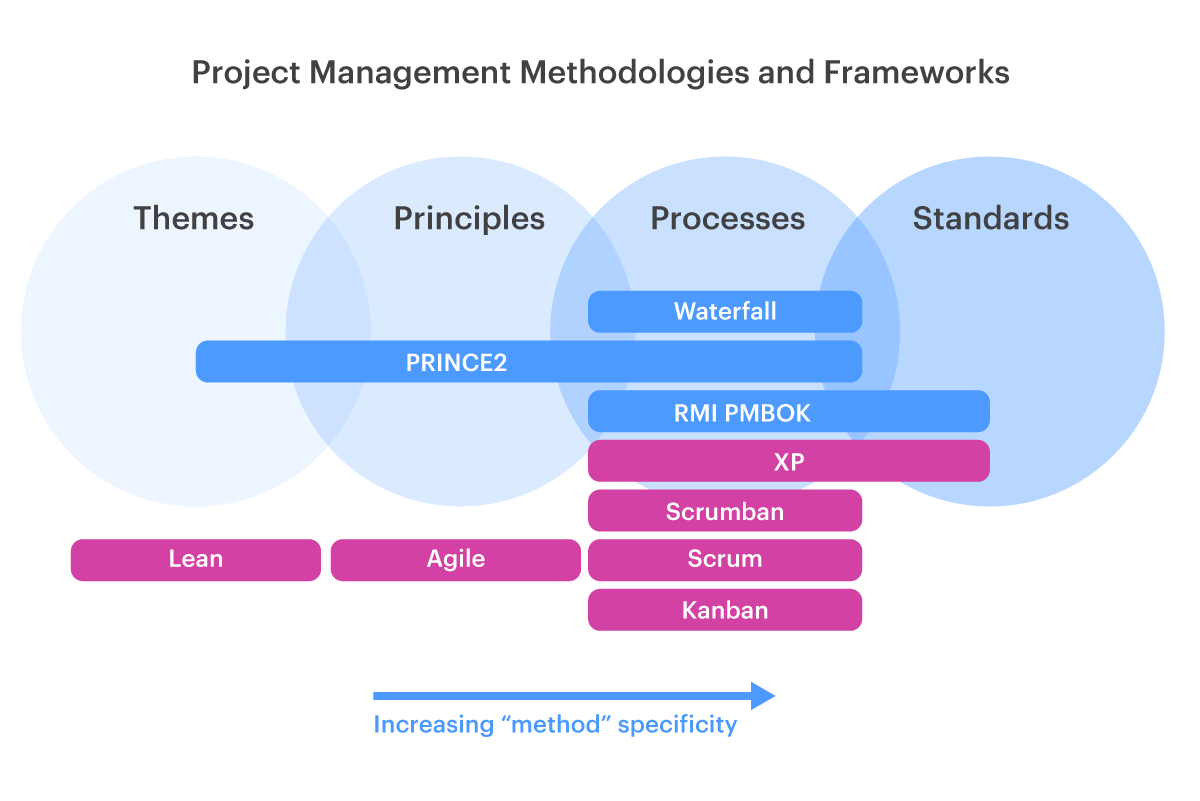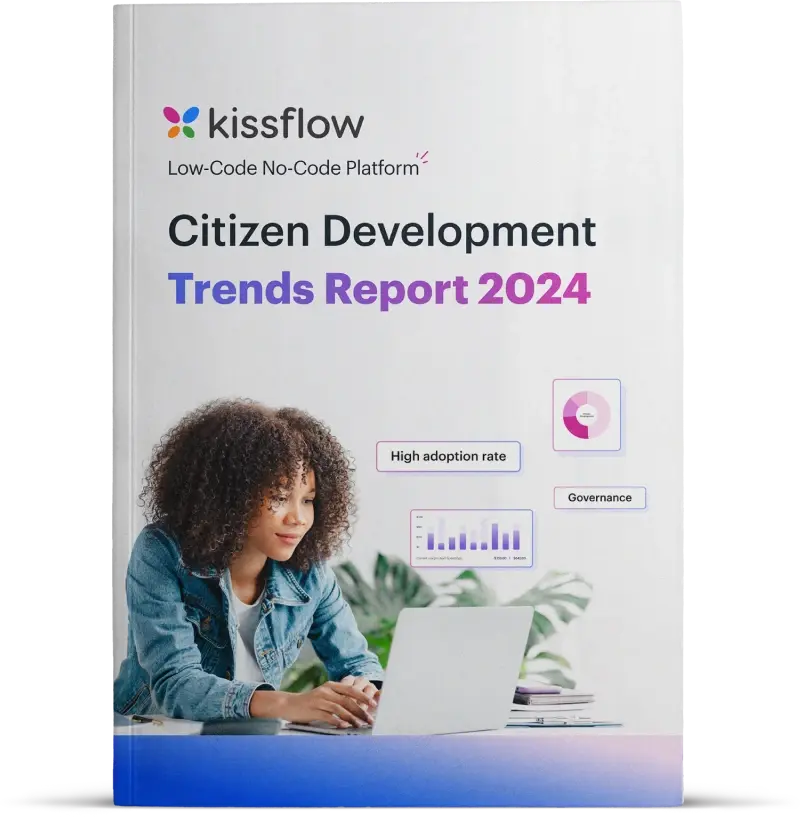
Project Management Methodologies and Frameworks Explained
Those new to project management often confuse methodologies and frameworks. Learn how both are different and what some notable methodologies and frameworks are.
Projects fail all the time. According to a recent Standish Group report, only 36% of projects succeed in meeting the requirements. Why do so many projects veer off track?
There are a number of reasons–from a change in the organization’s priorities and project objectives to procrastination and task dependency. But most of them point towards a common factor that is lack of clear direction.
In project management, without adequate requirements and objectives, projects are subjected to,
- Scope creep
- Budget overruns
- Delays
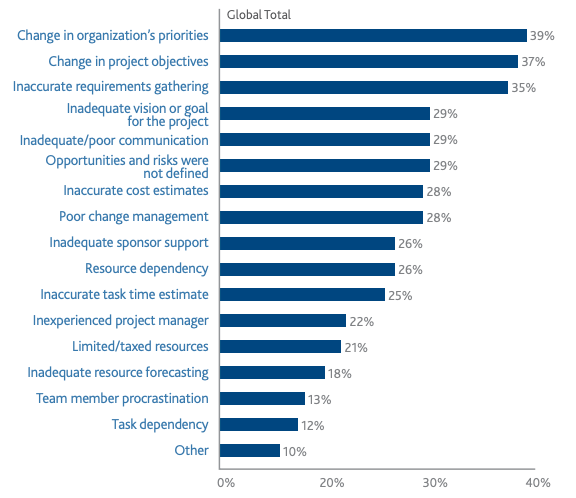
Source – PMI’s Pulse of Profession Report, 2018
However, there is a simple way to avoid most of these roadblocks and that is using various styles of project management methodologies and frameworks.
Table of contents
- What is Project Management Methodology
- What is Project Management Framework
- Difference between Framework and Methodology
- How to Choose the Right Methodology or Framework
- Types of Project Management Methodologies and Frameworks
- Waterfall Methodology
- Critical Chain Project Management Methodology
- Agile Methodology
- Kanban Framework
- Scrum Framework
- Lean Methodology
- Prince2 Methodology
- Summary
Let’s look at everything you need to know about the various techniques and approaches to project management frameworks and methodologies.
What is a project management methodology?
Project management methodology offers a clear project roadmap that lists all the steps required to deliver a project successfully. These project methodologies or techniques provide a defined governance structure, process guidelines, test activities, processes, and deliverables. They take a well-detailed, rigid, and repeatable approach towards project management.
What is a project management framework?
The project management framework provides structure and direction to a project. However, unlike project management methodologies it is neither too detailed nor too rigid. Frameworks guide projects to their goal while being flexible enough to adapt to evolving conditions.
It exists to offer project managers the guidance they need to achieve outstanding results.
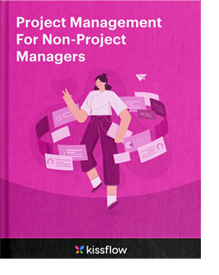
Want to learn project management but put off by jargon?
Learn what's important in the simplest ebook for non-project managers.
Framework and Methodology – What’s the difference?
Project management methodologies and project management frameworks are often used interchangeably. But those two project management approaches are actually quite distinct.
| Framework | Methodology |
|---|---|
| Gives an overview of how guidelines can be implemented | Offers rigid rules and practices for completing a project |
| Offers space for creative adaptation | Is pretty rigid and prescriptive |
| Preferred by experts | Preferred by beginners |
| Makes it hard to develop and implement performance metrics | Spells out all performance guidelines in granular detail |
| Leaves room to include other practices and tools | Cannot be embedded with other practices and tools |
| Traditional project management (PMBOK) is a framework | PRINCE2 is a well-known project management methodology |
While these two project management approaches are inherently different, when it comes to applying those definitions, there is a general disagreement in the project management community.
For instance, most experts consider “Agile Methodology” a framework despite the fact its name says methodology. This just proves that no matter how comprehensive your classification is, it can be considered arbitrary.
Ultimately, what matters is not whether a concept is a framework or a methodology, but how well it is suited for a specific project.
And don’t forget to try our Free and Customizable Templates:
– Content Calendar Template for Strategic Content Planning
– Competitive Analysis Template for Strategic Content Planning
How to choose the right project management methodology and framework
Project management methodologies and frameworks will be useful only if you take a practical approach to implement them. When a framework or methodology is forced upon a project, it will end badly.
On the contrary, if you make the effort to understand the nuances of a methodology or framework and tailor it to fit your business needs, you’ll wind up with a successful project.
Since there is an array of project management techniques available in the market, it can be a bit challenging to pick the right one.
Types of project management methodologies and frameworks
Comparing the most popular techniques to project management methodologies and frameworks:
- Waterfall Methodology
- Critical Chain Project Management (CCPM)
- Agile Project Management
- Kanban Methodology
- Scrum Methodology
- Lean Project Management
- PRINCE2 Methodology
1. Waterfall methodology
The waterfall or traditional methodology is sequential and linear in nature. It is made up of static phases that are executed one after the other in a particular order. While the waterfall methodology allows more room to control each phase of the project, it doesn’t react well to ad-hoc project scope changes.
| Origin | Inherited from the manufacturing and construction industry where iterations cannot be afforded |
| Nature | Tasks on waterfall projects are classified into groups (phases) based on their activity type |
| Risk | A phase starts only when the previous one ends, so there will be a delay even if one phase is late |
Phases in waterfall project management
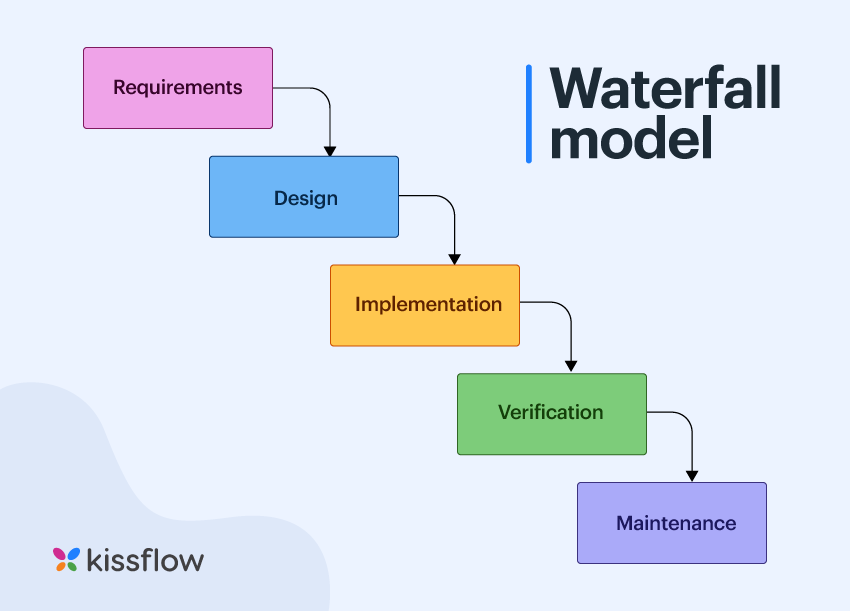
Typically the waterfall method comprises of five important phases:
- Requirements – business needs and project requirements are analyzed and documented
- Design – make a detailed plan on how to accomplish business and project goals
- Implement – implement the project plan and set baselines to measure progress
- Control – compare project performance with plans and fix problems that arise
- Closure – share project accomplishments with clients, get final approval, and close project
When all these activities are listed out on a Gantt chart, it resembles the slopes of a waterfall, and hence it is named the Waterfall model.
Advantages of waterfall methodology
- Extensive documentation
- Low chance for knowledge loss
- Sets clear client expectations
- Requires minimal client input
- Easy to understand and measure
Limitations of waterfall methodology
- Changes are expensive and difficult
- No room for error in requirements
- High chance for deadline creep
- QA becomes a bit irrelevant
- Hard to foresee and prevent problems
Waterfall methodology is better suited for projects,
- where budget, requirements, and scope are clearly defined
- Which have an accurate work estimate
- that can’t afford iteration
- when there is a low chance of risk
- with a hardship date
Waterfall methodology is not suited for projects,
- when there is no clarity about requirements and the end product
- where requirements and industry standards change rapidly
- when you need a working prototype in the first go
- where you need to incorporate user feedback later down the road
2. Critical Chain Project Management Methodology
Critical chain project management (CCPM) helps project managers deliver timely and cost-effective projects by taking resource and task dependencies into account. It spots strategic points in project scheduling and inserts buffers to ensure that each project milestone is hit on time despite limited resources and project uncertainties.
Determining the critical chain
The first step in identifying the critical chain is figuring out the critical path. Then, load resources along the critical path. This may or may not cause a change in the critical path depending on the resource crunch.
The critical chain is the resource-constrained critical path. Once the critical chain is identified, buffers are added to nullify any uncertainty.
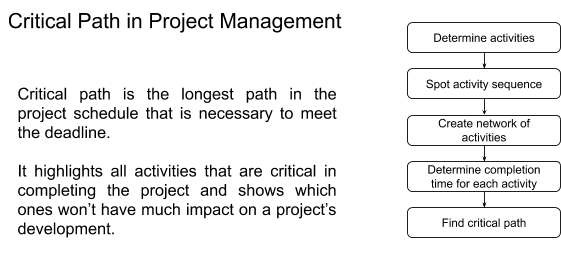
Buffers
Critical chain project management uses buffers as a safety margin to ensure that all tasks are completed within the project schedule.
Listed below are the four common types of buffers used:
- Project buffer: Positioned at the end of the project between the last task and the completion date to keep the project completion date unchanged. The size of the project buffer depends on the activity duration in the critical chain.
- Feeding buffer: Placed at points where the non-critical chain meets the critical chain. It prevents delays in the non-critical chain from affecting the function of the critical chain.
- Resource buffer: Inserted in the critical chain to ensure that critical resources are available throughout the project whenever required.
- Capacity buffer: Deployed to set on-call resources wherever necessary in the case when several resource constraints arise all at once.
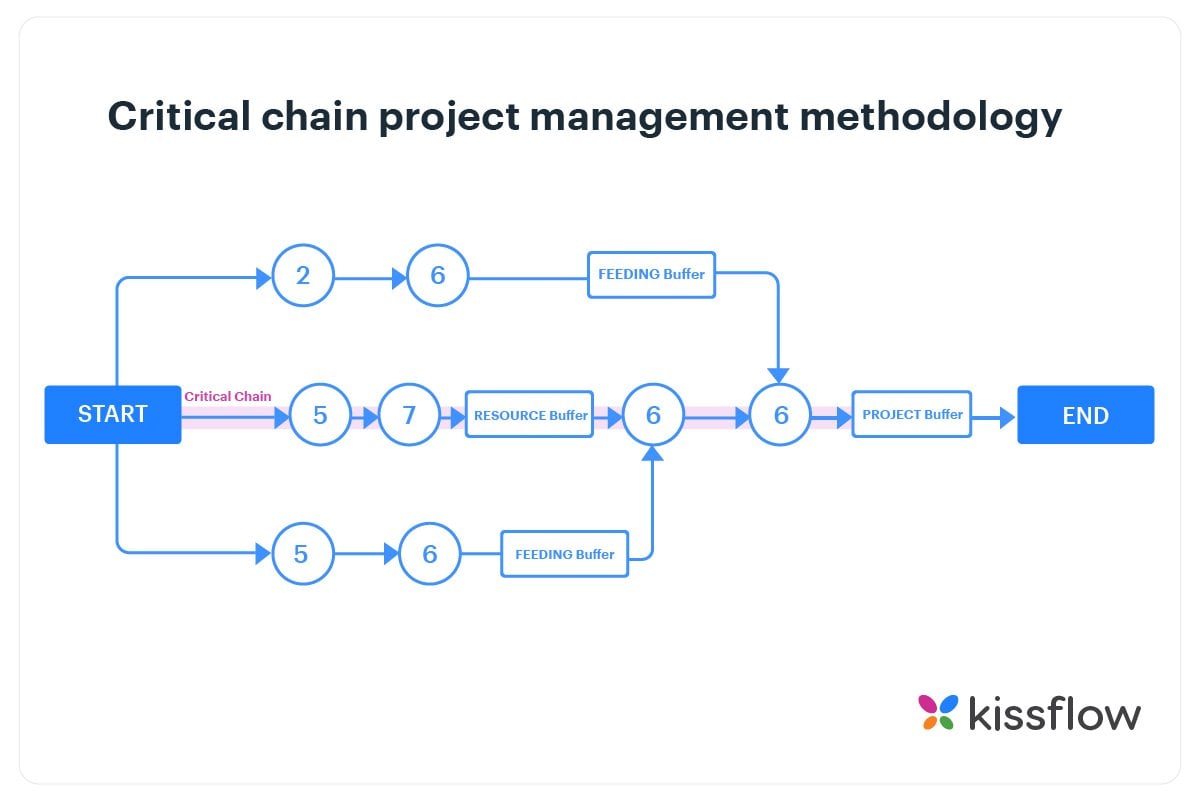
Compared with other project management approaches, CCPM has a pretty straightforward way of implementation.
Listed below are nine steps involved in creating a smooth critical chain:
- Cut down all-time estimates by half (50%)
- Optimize utilization by scheduling work around resource availability
- Introduce a project buffer at the end of the project
- Insert feeding buffers to eliminate any chance of schedule deviation
- Use resource buffers to protect the critical chain from resource conflicts
- Position capacity buffers wherever required
- Prevent bad multitasking by scheduling tasks as late as possible
- Promote aggressive task completion
- Manage buffers efficiently to enforce control
Benefits of Critical Chain Project Management methodology
- CCPM is primarily used in multi-project scenarios that demand a huge amount of resources
- It can be applied to any project regardless of its size
- Resources that are in limited supply are exploited to their maximum efficiency
Being the most practical project management approach it offers a number of benefits like:
- Allowing people to focus more on tasks
- Improving team productivity and efficiency
- Enabling employees to overcome student syndrome
- Accelerating project completion time
- Reducing capital requirements significantly
- Optimizing resource utilization
3. Agile methodology
Agile methodology is an iterative and people-centric approach to project management that focuses on responding to change over following detailed planning.
It reduces the complexity of a project by breaking down the project cycle into smaller segments allowing room for changes at later stages. To be an agile project it needs to follow the core values and key principles defined in the Agile Manifesto.
What is the Agile Manifesto
A methodology is defined as agile if it follows the values and principles defined in the Agile Manifesto. Rather than prescribing how a project needs to run, the agile manifesto defines the mindset on how best to manage projects.
The four core values listed below in the agile manifesto take up the heart of what it means to be agile.
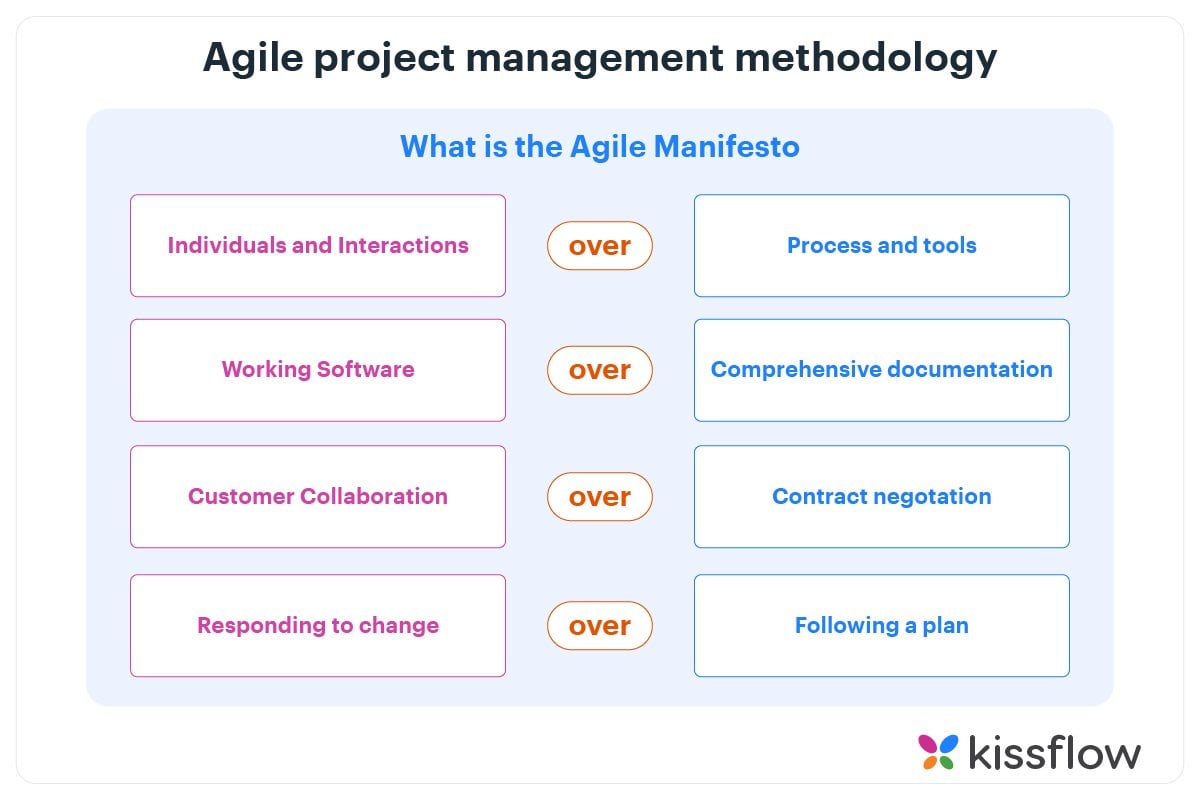
The agile manifesto also includes twelve key principles that are listed below:
- Keep customer satisfaction high through early and rapid software delivery.
- Embrace requirement changes even in the later stages.
- Make frequent software delivery a habit (weeks instead of months).
- Ensure regular stakeholder collaboration.
- Give the implementation team everything they need and trust them to accomplish goals.
- Face-to-face conversations play a huge role in a project’s success.
- Use working product/service as the ultimate measure of progress.
- Maintain a constant pace to ensure sustainable development.
- Pay attention to technical excellence and decent design.
- Keep simplicity as a goal.
- Make teams self-organized to obtain the best architecture, requirements, and design.
- Finetune team behaviors regularly to enhance efficiency.
Advantages of the agile methodology
Agile is perfect for SMBs since the fewer people, the easier it is to keep up the pace and embrace change. It also works great for project management for startups that work on the fail-fast mantra. The agile methodology delivers the value sooner to a customer through quick software deployments. The wastage of resources is less since the tasks are always up-to-date.
Since the cost is low, there is more room for experimentation. As an agile approach detects and patches up the issues faster, it has a faster turnaround time. Best of all, the huge community following comes in as a great help when you hit a wall or run into any trouble in your project.
Not sure if Agile is the right choice for your project? Take a look at the questionnaire given below. If your answer is ‘yes’ for the majority of these questions, then agile might be a perfect choice for you!
- Do you intend to capture the market before the competition picks up?
- Are your customers/clients available for extensive involvement?
- Can you afford iterations?
- Do you have no need to deliver fully functional software immediately?
- Do your clients have a flexible budget or schedule?
- Are you free from the complex bureaucracy that delays decisions?
- Would you like to map out the design through trial and error?
Agile frameworks
The agile project management style supports a wide range of frameworks. A few frameworks like Extreme Programming focus on the practices whereas other agile frameworks like Scrum and Kanban focus on managing the flow of work.
Listed below are some of the popular agile frameworks:
- Dynamic Systems Development Method (DSDM)
- Extreme Programming (XP)
- Feature-Driven Development (FDD)
- Kanban Project Management framework
- Scrum Project management Framework
- Crystal Methods
Agile is not for everyone
While agile’s highly flexible approach makes it seem alluring, it doesn’t work well with all projects. For instance, a marketing agency could never adopt the agile method since the clients may not be interested in half-baked marketing ideas that need too many iterations and revisions. In this case, working increments don’t exist, only deliverables matter.
While the agile methodology has a number of advantages, it has its fair share of drawbacks as well. As this approach doesn’t place much importance on documentation, it is extremely difficult to bring new team members up to speed. As progress happens over a number of cycles, measuring it is much harder when compared to the waterfall approach.
The need for constant communication in project management demands more time and energy from everyone. Since there is no clear end, projects can go on forever and ever. There is a high chance for scope creep and experience riot.
4. Kanban framework
The Kanban framework is a method that helps businesses plan and organizes project activities visually by prioritizing tasks on boards.
It is one of the clearest, simple, and most effective project management tools. In simple terms, Kanban helps project managers manage their tasks, documents, lists, and files in a single interface.
Kanban board
A Kanban board is a project visualization tool that helps team management work effortlessly. Kanban boards are usually represented as interactive panels with virtual sticky notes that can be moved around easily to organize tasks and to-do lists.
The Kanban board represents a project workflow where columns show the steps in a process and list down the relevant tasks involved. Every Kanban board is made up of Kanban lists and Kanban cards.
A list or lane holds a set of interconnected cards that are in the same stage of a process. Each card describes an individual task or activity and includes essential data for a specific task. These cards are usually represented in a specific color code depending on the nature of the task and the stage it is in.
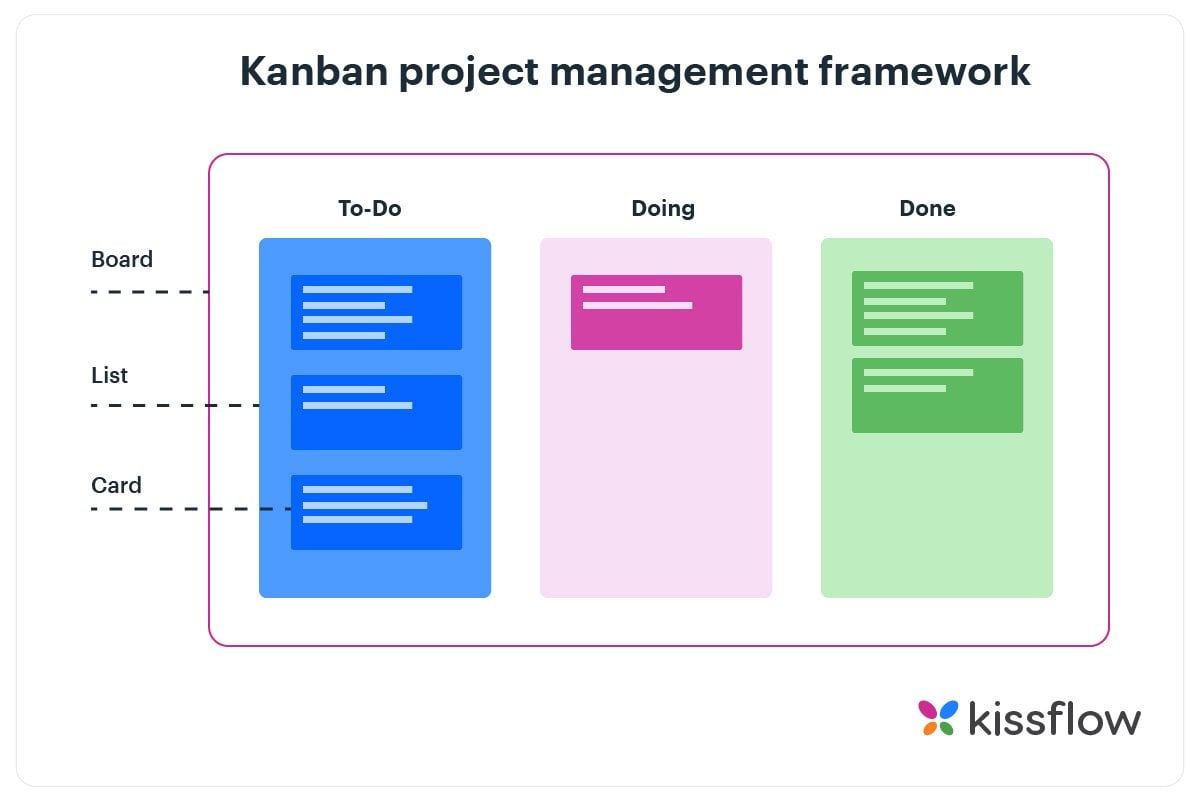
The Simplest Kanban board consists of three sections:
- Yet to be started (To-Do)
- Work in Progress (Doing)
- Completed Work (Done)
Once the tasks are delegated, team members will move these cards across sections depending on the task status. This method helps teams minimize resources and make changes in the project as and when the demand arises.
Core practices of Kanban framework:
To create a positive outcome using Kanban, it is essential to follow the five core practices and four basic principles of Kanban project management.
Five core practices of the Kanban project management framework are:
- Visualizing work
- Reducing the amount of work in progress
- Managing flow effectively
- Making explicit management policies
- Improving performance through collaborative work
These core practices are created based on the four basic principles that underlie this revolutionary task management framework called Kanban.
Basic principles of Kanban framework:
1. Start with existing workflow
Kanban framework can be implemented without making drastic changes to the existing workflow. It is rather easy to overlay Kanban properties and address issues over time.
2. Pursue elaborate change
There will be minimal resistance from stakeholders when small yet evolutionary process changes are actively encouraged.
3. Respect current roles and responsibilities
Accepting and respecting current roles and responsibilities will foster more support for the Kanban initiative helping businesses to implement the Kanban system more easily.
4. Encourage leadership at all levels
Rather than depending on team leaders or executives, Kanban reaches optimal results by making teams stay self-organized.
Benefits of using the Kanban framework
Kanban improves a project’s efficiency over time without massive and radical change.
Kanban Framework offers projects a number of benefits like:
- Highlighting process bottlenecks
- Enabling continuous improvement
- Limiting multitasking and improving quality
- Delivering positive results much quicker
- Allowing project re-prioritization at any time (based on business or customer demand)
- Enhancing team collaboration
- Offering a transparent overview of project status
Is Kanban suitable for your project?
While Kanban board software is a great tool to improve existing processes that don’t work well, it is not the best option for complex product development. As it is rather loosely structured, it might not work well for projects that demand a perspective approach.
And don’t forget to try our Free and Customizable Templates:
– Marketing Plan Template to Streamline your Marketing Efforts
– Social Media Calendar Template for Social Media Planning
5. Scrum framework
The term Scrum originated from rugby. In rugby, the process where a team huddles around the ball and attempts to pass it down the field to win is referred to as Scrum. The scrum framework helps every person in the team to work together and complete a project successfully.
What is the Scrum framework?
Scrum framework is the most widely used Agile methodology that enables small, closely-knit teams to create complex products in an incremental way. The Scrum framework decomposes work from the visionary and strategic level to easily consumable, actionable tasks that all team members can work on during a sprint.
Scrum values have five fundamental rules that can be implemented in your scrum project management framework which helps teams to improve performance daily.
How Scrum project management works
In a Scrum environment, the complete workflow is built around a sprint. Unlike the waterfall methodology that locks up resources several months in advance, Scrum allows the team to focus on scrum sprint meetings with a handful of tasks for two weeks, reflect on results, and then decide what to work on.
Before Sprint
Before you start every sprint, any agile marketing team needs to plan what they’ll work on for the next two weeks. The process starts with the product owner describing the desired goal for the sprint.
Based on this, scrum master creates a list of tasks that need to be completed within the sprint.
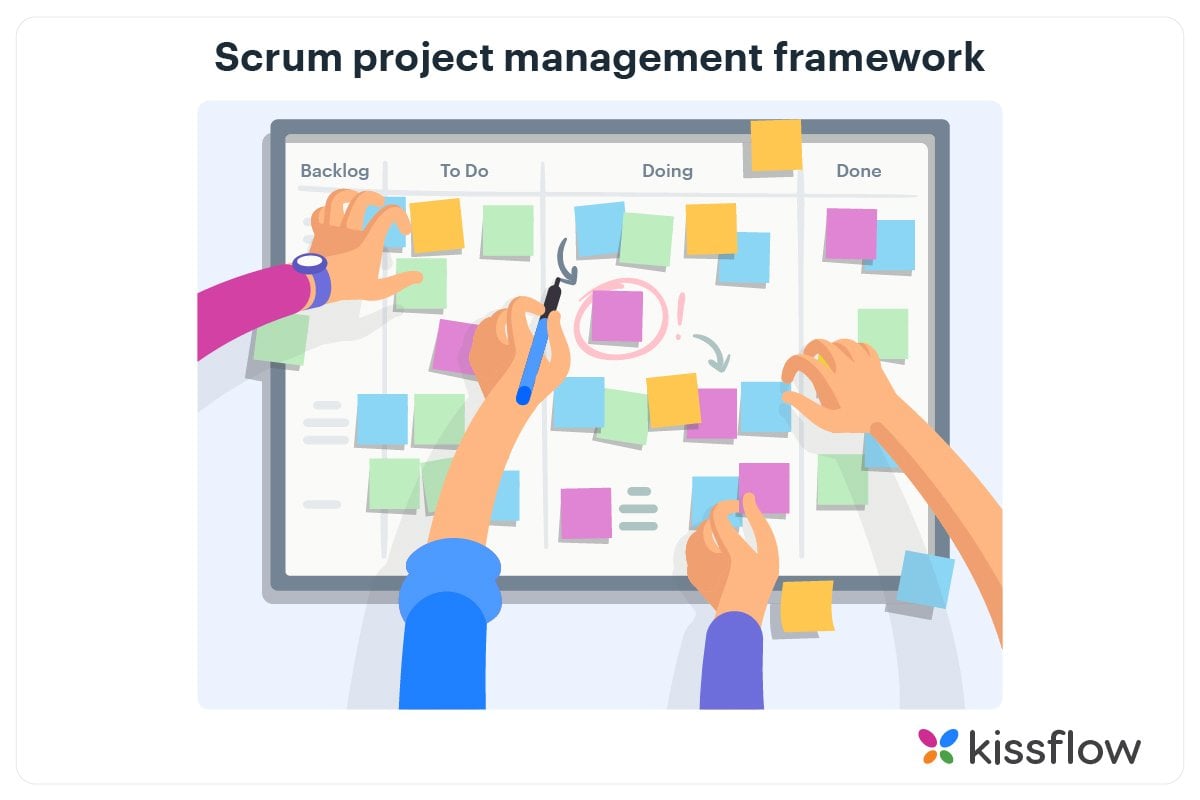
During Sprint
Once the sprint starts, the scrum master will distribute the work and coordinate team members to get things done on time.
Here is how the team gets work done during the sprint:
- A visual scrum board is used to visually manage and track tasks
- The board is split into several task lists (columns)
- Once tasks are listed, individuals pull tasks and start working on them
- After completing the work, it is sent to quality check or testing
- If the task fulfills the Definition-of-Done, it is ready to be shipped
In addition to executing the task, the team also does a daily stand-up where everyone shares a quick status update and measures the project progress using a burndown chart that shows a visual representation of work left to do versus time.
After Sprint
Once the sprint ends, the team gets together to look back on what they have accomplished. Typically, the reflection phase consists of a review session (see what has been accomplished and what is yet to be done) and the sprint retrospective session (discuss the process of what went well and what can be improved).
After this, the team comes up with new sprint goals and decides what they need to focus on during the next sprint.
Scrum roles
There are 3 roles in the Scrum project management framework:
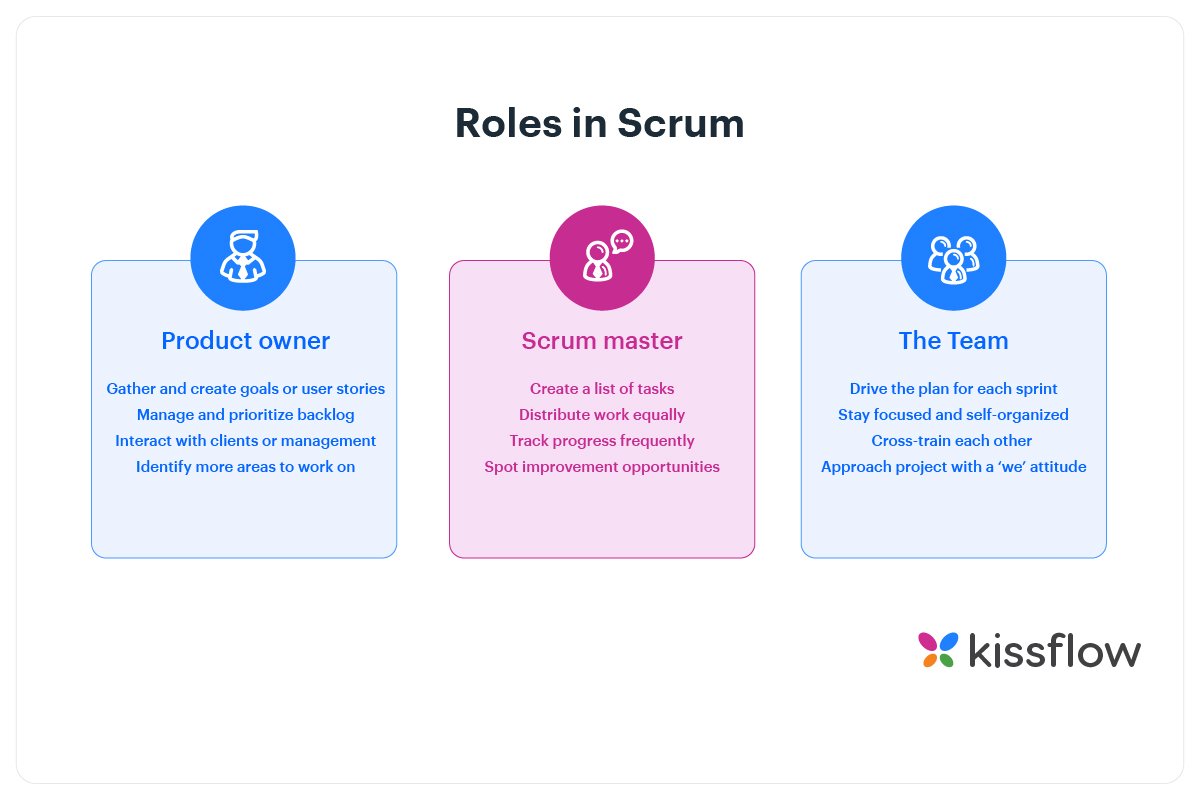
1. Product owner
Product owners are visionaries who ensure that the team and scrum masterwork on goals that are aligned seamlessly with the business goal. They spend more time with the stakeholders and clients. They focus more on the end result than the mode of implementation.
2. Scrum master
Similar to a project manager, every scrum master ensures the enforcement of the scrum framework and focuses on facilitating team management. Unlike project managers, scrum masters don’t manage people as it goes against agile principles.
3. Team members
Team members take care of the actual work. Being inherently cross-functional, team members handle everything from analysis to execution and verification. Members of a scrum team are highly self-organized and so they perform efficiently without any supervision.
Scrum works better for small teams that consist of up to a maximum of 9 people. The team dynamics of large teams render Scrum ineffective.
6. Lean Methodology
The lean methodology has its origins in the manufacturing units of Toyota which revolutionized the production of physical goods in the 1950s. A few decades later it found applications in knowledge work as well, helping businesses eliminate lean wastes, improve processes, and work with tighter budgets and shorter deadlines.
5 principles of lean
There are five key Lean principles in Lean Project Management Methodology:
1. Value
Specifying the value to the customer is one of the core principles of the Lean framework. Even before you start a project, define what value it brings to the customer. This mindset and clarity will help you work on the functionality and features your customers need.
2. Value stream
It’s important to map the value stream for the entire cycle of the project starting from the required materials to delivery to the customer. Once the value stream mapping is done, each step is analyzed to identify areas of waste. So it’s essential to map every step, material, process, and feature.
3. Flow
After eliminating everything that doesn’t add value, there should be a smooth flow of sequential steps. There shouldn’t be any delays or interruptions that will prevent you from achieving your final goal.
4. Pull
The project should move forward and managers should take action only when the customer demands it. As opposed to traditional approaches that involve forecasts to push work, Lean ensures teams won’t take steps ahead of time so as to avoid waste and reduce inventory.
5. Perfection
Lean emphasizes chasing perfection through continuous improvement. Regularly reassess your processes with the goal of eliminating waste and maximizing efficiency.
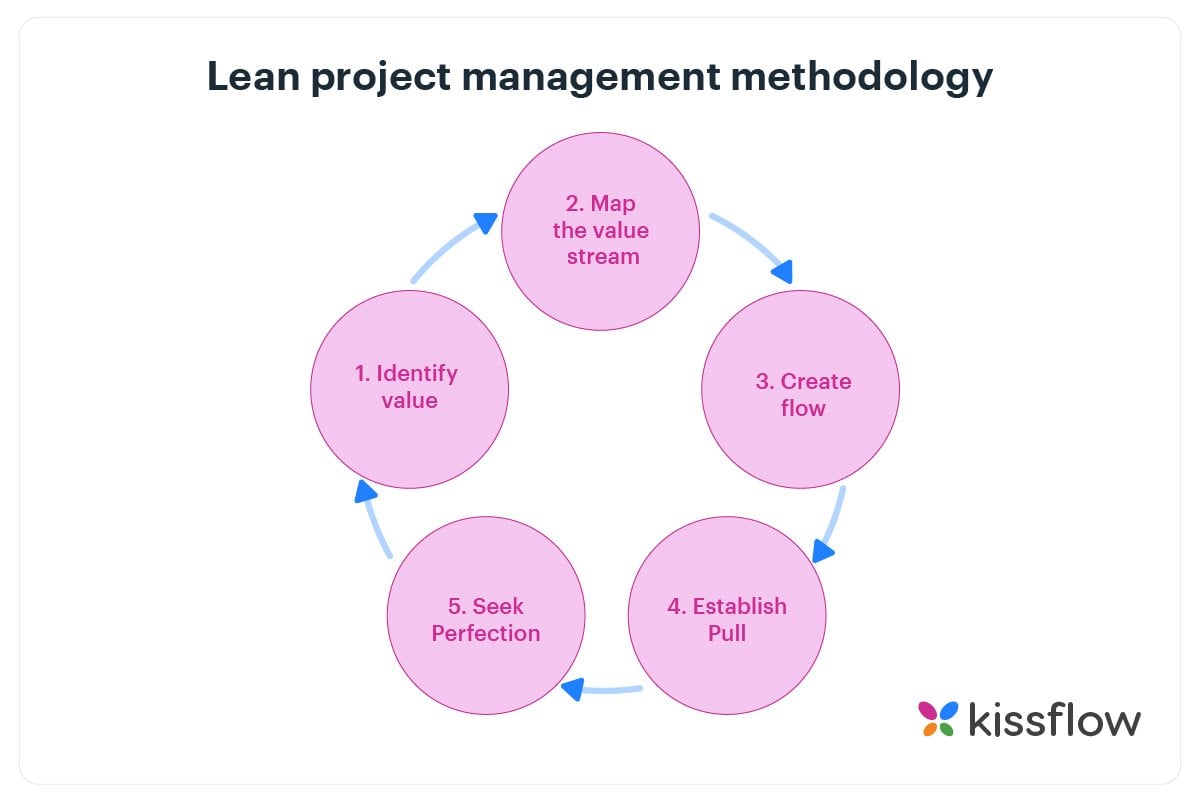
Benefits of the Lean methodology
- Since the core of Lean is the minimization of waste and providing value, it results in increased profits and reduced costs
- Since it puts the focus on the customer and delivering exactly what they want, it improves the interactions and relationship with your customers
- There is no chance of overproduction and excessive inventory
- It results in an increased quality of products as one of the goals is to reduce rework and defects
- Lean brings regular communication among employees, managers, and stakeholders, it leads to better decisions
Lean doesn’t work well for projects when
- the company is undergoing a major change
- a project or process is in transition and not end-to-end
- a project does not have clear OKRs
- the project is expected to produce vague results
7. PRINCE2 methodology
PRojects IN Controlled Environments (PRINCE2) is a full-fledged, process-based methodology that describes every aspect of project management in a detailed manner. It clearly states how every step should look like, clarifies deliveries in great detail, defines roles and responsibilities perfectly, and more. This is a go-to methodology for large enterprise-level projects.
Why PRINCE2 is important
PRINCE2 addresses the common reason for project failures by providing a pretty detailed way to keep the project easily organized. It not only structures every stage of the project effectively but also ties up all loose ends once the project is completed.
PRINCE2 project management methodology helps you:
- Increases the quality of finished products
- Controls resource consumption efficiently
- Keeps the regulation level balanced
- Improves the project team’s confidence
Nature of the PRINCE2 methodology
The PRINCE2 methodology is a mixture of 7 principles, themes, and processes.
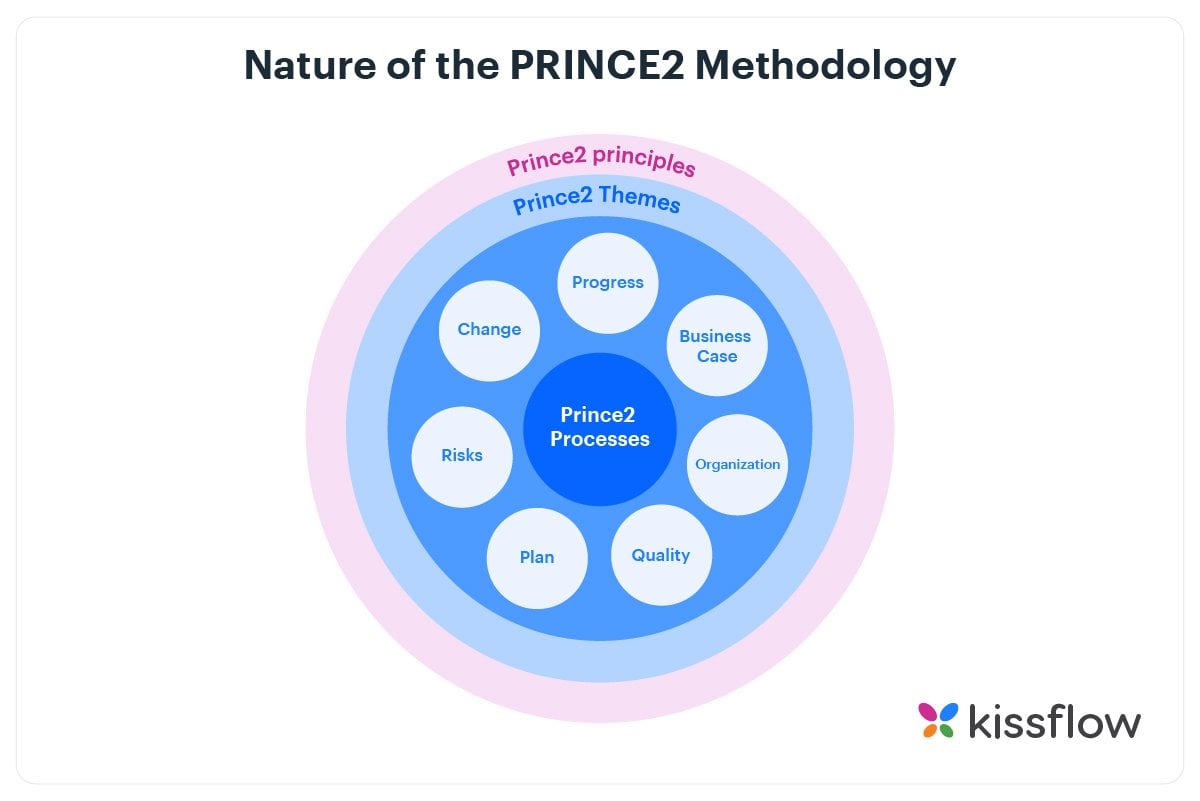
Basic principles of the PRINCE2 methodology
The seven basic principles of PRINCE2 project management methodology are:
- Ensure continued project viability with realistic benefits
- Learn from previous mistakes and keep updating knowledge
- Define roles and responsibilities clearly
- Always stay focused on the quality of project deliverables
- Flexible to meet the unique needs of each project
- Manage the project in controlled, pre-planned stages
- Delegate authority based on the stakeholder’s role
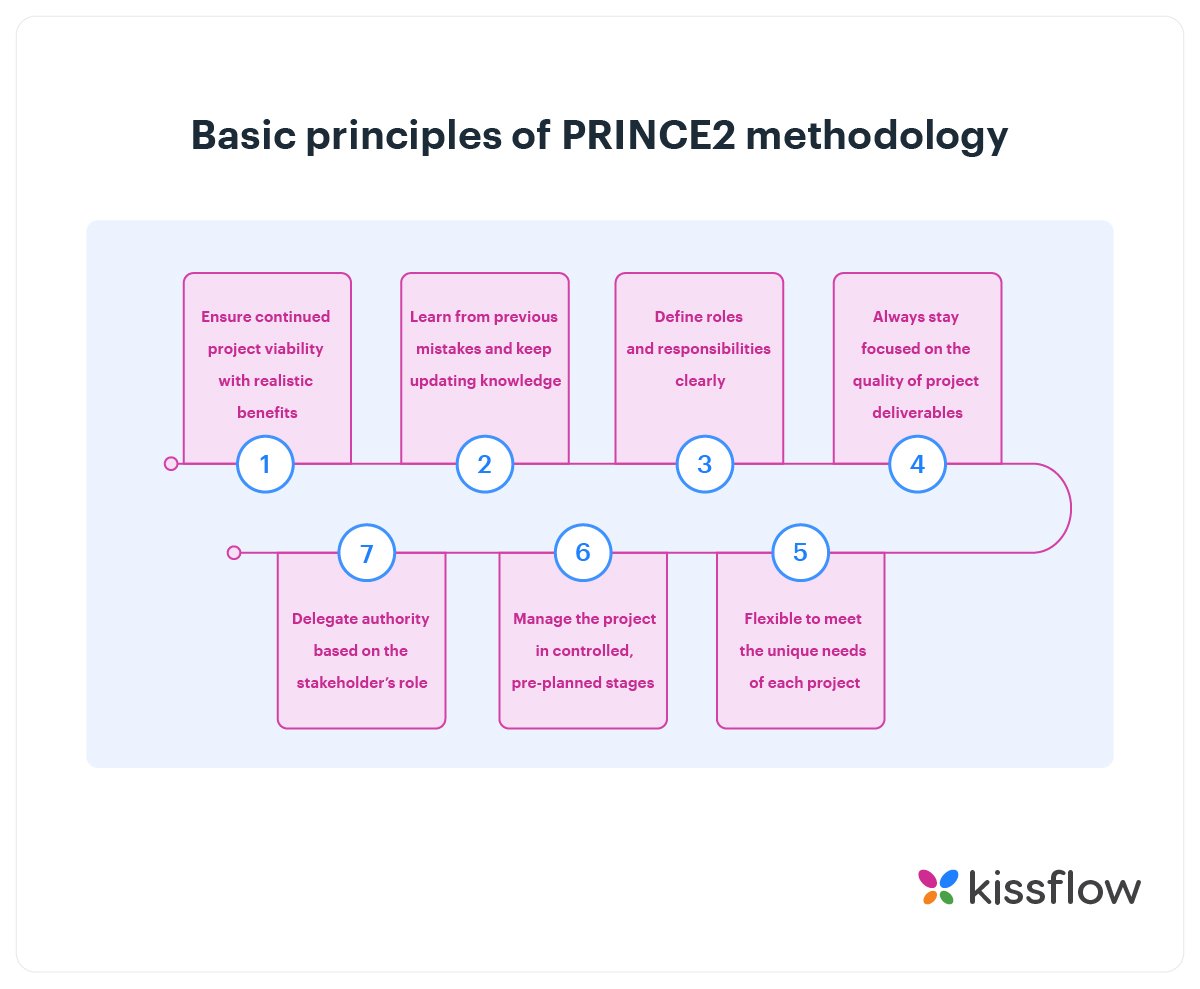
Advantages of PRINCE2 project management
- It’s relatively simple and makes it easier to manage the projects by dividing them into different stages
- Makes it easier to communicate among teams and stakeholders
- The methodology can be adapted to suit the needs of different projects
- It improves accountability by defining clear roles and responsibilities
Disadvantages of PRINCE2 project management
- It doesn’t offer the level of flexibility offered by postmodern project management methodologies.
- It is unsuitable for projects in fast-changing technological environments because of its extreme emphasis on documentation.
Summary
Your choice of project methodology will have a profound impact on your approach to work and how you communicate with your teams. How you choose an approach or technique to project methodology will depend on your teams, the project scope, and the kind of projects you undertake. Some methodologies facilitate speed, while others are geared toward efficiency and profits.
Each of these project management methodologies comes with its own pros and cons and picking the right one will make your projects smoother and your teams more efficient. It’s important to understand that what worked for another team may not work for you. It’s best to test some of them and see how well they fit into your project needs.
Your search for Project Management has landed you here. Wondering why?
As a user, you'll experience the full value of Kissflow by implementing it across departments for diverse use cases rather than just addressing isolated needs like a project management tool for a single team or department.
Application Development Platform
Digital Transformation Platform
Related Resources
- How to Create a Timeline in Project Management – 7 Simple Steps
- Google Project Management Software: 6 Tools to Help Address the One Weakness of G-Suite
- Time Tracking in Project Management is Important. Here’s Why.
- The Ultimate Guide to Project Management Dashboard
